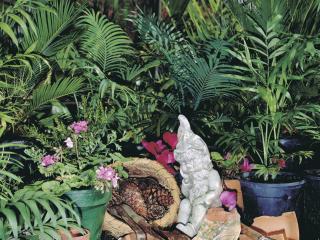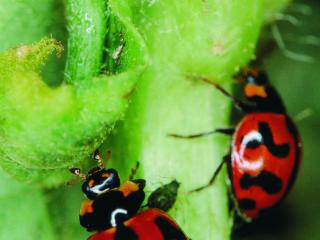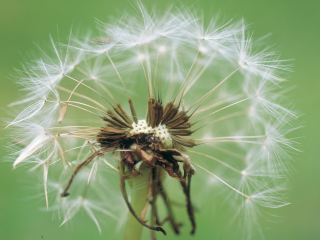Although gardens occasionally experience waves of seasonal pests, most common pests and diseases originate from within our gardens, and damage can be minimised if we understand the basics of their biology and the local ecology.
Within our fences there is usually a stable ecosystem in which plants, animals and pathogens coexist in a state of balance. As gardeners, we manipulate this ecosystem by supplying water and nutrients but, most of the time, our garden needs little looking after. It is important to keep this concept in mind when we disturb this balance by using pesticides or introducing a new plant, pet or pond.
Thoughtful garden design
When improving the soil buy products from a reputable source so amendments are disease and weed free and organic material and manure composted.
Thoughtful design allows for optimum interaction between man-made structures, plants and animals. Basic but important considerations include correct orientation so that the structures, trees and other large plants provide shelter from strong winds, create shade in summer, and let in winter sun. Creating zones for plants with similar requirements can minimise pest and disease problems and reduce watering.
Any style of garden will eventually progress towards a balanced ecosystem.
Soil health
A healthy soil contains many beneficial organisms (like earthworms, insects, nematodes, fungi and bacteria) and pathogens (some nematodes, fungi and bacteria). Organic matter, such as moist leaf litter or compost, provides the energy for soil microbes. Natural microbial activity in the soil breaks down organic material and releases nutrients to the plants.
Numbers of many soil pests are kept low by the action of these beneficial organisms. On very sandy coastal soil the addition of clay (from 0.5 to 2kg per sqm) worked into the top 30cm will improve soil properties and, together with added compost, will improve the soil’s capacity to retain water and supply nutrients to the plants.
The home gardener can convert home and garden waste to good soil by building a compost heap. Establishing worm farms is another method of obtaining good compost.
As a rule healthy soil and plants which are well watered and fertilised create healthy plants which are less susceptible to pests and diseases.
Insect control
Harmful insects, nematodes and fungi are naturally controlled by beneficial nematodes and fungi, predatory and parasitic insects, birds, frogs and lizards. A number of beneficial insects are sold by integrated pest management companies.
Beneficial organisms can be attracted by providing the right environment — trees for birds, specific plants for certain insects and ponds and shelter for frogs and lizards. Control your cat, keep it in at night and fit it with a bell to protect birds and lizards.
Beneficial insects are attracted by the flowers of some plants, especially members of the Umbelliferae family like carrot, parsley, coriander and dill. Spiders and preying mantids also should be encouraged as they feed on insects.
Some plants can be used as bait crops — for example, provided both of them flower at the same time, groundcovers can be used under fruit trees to detract the western flower thrips from the fruit tree flowers.
Reducing pest numbers
Snails and slugs are attracted to wet conditions and feed on young, juicy plant material. These pests and slaters can be controlled with physical barriers like sawdust, sand, shell grit, or iron-based snail pellets that are less toxic to children and animals.
Seasonal pest control
Good garden management can reduce certain seasonal insect pests. For example, ash white fly on claret ashes will disappear at the end of the season when the trees shed their leaves, but you must dispose of the old leaves to avoid the larvae breeding for the next season.
Garden management techniques will minimise many household pests that originate in the garden. For example, Portuguese millipedes breed in organic matter and are attracted to house lights. Position outside lights and traps to detract them away from the house. Confine and turn compost heaps which can otherwise harbour pests like cockroaches and flies. Chickens and ducks will control snails, slugs, slaters and many insects
To avoid attracting foxes, rats, mice and cats remove food scraps after outdoor meals and keep pets’ feeding bowls clean.
Reducing disease
Fungal infections can occur on wounded plants located in situations ideal for the fungi to thrive — for example, bean rust thrives in warm, moist conditions, and common potato scab is a problem in very alkaline soils.
Most plant fungal infections are encouraged by humid conditions aggravated by crowded plants with poor ventilation, and watering in the evening. Simply change these conditions by thinning the foliage and watering early in the day.
It is also important to rid the system of fungal spores whenever possible. Seal all infected plant material in plastic bags and bin it — never add it to the compost heap. Also sterilise garden tools and support stakes.
If good management fails to give adequate control of pests or diseases problems can be treated with an expanding range of natural organic substances. Aim to use products that are target — specific rather than broad spectrum, as the latter can harm beneficial organisms as well.
One year’s seeding and many years of weeding
It is crucial to remove weeds before they flower and set seed. Weeds can be smothered with newspaper, sawdust and thick mulch. A good groundcover will reduce the opportunity for weeds to establish.
Many gardeners find it acceptable to use glyphosate on stubborn weeds because, although it is a chemical, it does not affect the soil structure and may not affect anything else provided you wipe it on instead of spraying.
Using uncomposted manure to build up soil can also lead to weed introductions. Doublegee seeds can be brought into the garden in horse and sheep manure and wild oats seeds can be in bales of straw. Mulch with hay instead of straw.
Research a plant’s growth habit before introducing it into your garden as many vigorous ones have the capacity to become weeds of gardens and bushland.
Aquatic plants will shelter fish in ponds from birds, but never use salvinia and water hyacinth as they are serious weeds of waterways and are prohibited in Western Australia.
Keep records of seasonal problems
Being forewarned of garden problems allows the garden owner to judge the best time to take preventative action.
Keep records of when pest and disease problems occur on certain plants so that the following year you can avoid growing that particular flower or vegetable at the same time, or choose a different variety, or a different location.
Familiarise yourself with the insects and animals that normally visit your garden so you will be more aware when something unusual appears.
Pest and disease control
If alternative methods have been tried, and pests or diseases are in bad proportions, you may want to consider the following options:
- Do nothing, the problem may disappear naturally.
- Remove pests by hand.
- Make alternative sprays from chilli and garlic.
- Use registered chemicals as a last resort.
Unfamiliar pests, diseases and weeds
The Department of Agriculture and Food Western Australia (DAFWA) is on the lookout for animal and plant pests, diseases and weeds that could pose a threat to agriculture and the environment.
If you discover something unfamiliar please contact the Pest and Disease Information Service (PaDIS) on Freecall No: 1800 084 881 or send a photograph by email: info@agric.wa.gov.au.
Please read the sending specimens for identification article before sending specimens or samples to the Pest and Disease Information Service, 3 Baron-Hay Court, South Perth, 6151.



